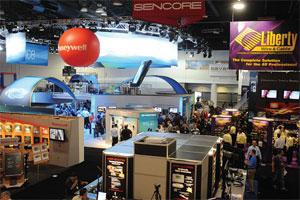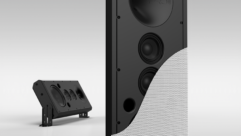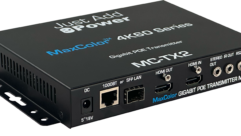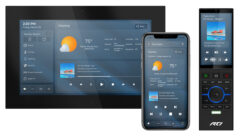

CEDIA Expo gave pros a look at residential technology
As you might expect in trying economic times, attendance at CEDIA Expo 2008 was off. But that didn’t stop major manufacturers from rolling out new products and technologies for the residential (and in some cases commercial) installation market. What was in it for your business? How about flicker-free flat-panels, IP-based systems, and AV servers running Windows?
SENATOR BARACK OBAMA AND THE DEMOCRATS had just left Denver when the Custom Electronic Design and Installation Association (CEDIA) blew in for its annual Expo last month. (Quick aside: In a PRO AV Newsletter poll, the McCain/Palin ticket led the Obama/Biden ticket 54 to 46 percent). As you might expect in trying economic times, attendance at CEDIA Expo was off. But that didn’t stop major manufacturers from rolling out new products and technologies for the residential—and in some cases commercial—installation market. What was in it for your business?
A survey of PRO AV readers found that 40 percent performed residential work. And when InfoComm did its 2008 Market Forecast Survey and asked which market would show the greatest increase in demand for AV products and services, residential was the third-most popular answer, ahead of government, house of worship, retail, and others (only corporate and education ranked higher).
Whether or not you handle high-end home theater installs or other residential projects, technology is often born in that market and migrates into businesses, churches, and other pro AV spaces (think HD, 16:9, and in-wall speakers). So you may want to note some of the trends from CEDIA Expo, whether you work on residential projects or not.
TRUST YOUR EYES
The flat-panel display market hasn’t cooled, and manufacturers are doing their best to ensure their products don’t become commodities. Just when we got used to pervasive 120 Hz panels, Sony launched a 240 Hz model, the Bravia KDL-52XBR7 LCD TV. The display uses what Sony calls Motionflow to interpolate three new frames and supposedly create smooth, detailed images in high-motion scenes. Clearly, the utility of such a function is application- and source-dependent (in a sports bar, higher refresh rates may help enjoyment of fast-moving programming; in a videoconference room, the technology may be overkill). When the product ships in December, it will be important to see how the interpolation (basically creating video frames where none exist) works and whether there’s a visible difference.
The same holds true for the gathering wave of 1,000,000:1 contrast ratio panels from companies like Sharp, Sony, Samsung, and LG. At CEDIA Expo, LG was showing its LG90, 47-inch LCD TV. It’s an LED-backlit TV with the million-to-one contrast ratio that did, indeed, look strikingly better than other TVs. Samsung also touted its LED-lit Series 9 line, while Sharp unveiled limited edition 52- and 65-inch Aquos LCDs—all of them a million-to-one (and 120 Hz). While LG and Samsung use white LEDs, Sharp went with RGB, which the latter says will improve color accuracy and create more vivid images. Let your eyes be the judge.
IP EVERYWHERE
Most of the new flat-panels rolled out at the Expo also came equipped with Ethernet ports so they could have an address on the Internet. In a residential setting, this feature is hyped to give consumers TV access to YouTube and other content providers. In the commercial market, IP potentially means better AV asset management.
But Kevin Reinis, CEO of NetStreams, which had its commercial coming-out party at last June’s InfoComm (see “5-Minute Interview,” August), made the case for IP as investment protection and customer-relations tool. The company makes IP-based distributed AV systems and at CEDIA Expo significantly improved the sound and performance of its amplifiers—through software. Existing customers don’t have to replace their hardware, and with a software patch in hand, integrators have reason to call clients and offer them a nice upgrade while positioning themselves for other business.
WINDOWS INSIDE?
This may sound anathema to an AV pro (on the residential side, they’re just starting to get their minds around it), but Microsoft is serious about making its Media Center software a powerful AV platform. A bunch of companies launched the Media Center Integrator Alliance at CEDIA Expo. Most of the founding members are those you’d expect—Microsoft, Intel, HP—but even Crestron is involved, and according to Kevin Collins, the alliance chairman, interest at the show was greater than imagined.
Can this be serious? The company that invented the “Blue Screen of Death” designing a legit AV platform? Companies such as Lifeware and Niveus already build sealed, secure media servers based on Media Center (Lifeware’s new Lifemedia LMS-810 includes an impressive eight HD tuners and can feed 10 displays) and apparently other companies like them, too. At exhibits such as one by Samsung and another from Projectiondesign (the latter showed off impressive new Avielo HD home cinema projectors), one editor couldn’t help but notice the companies were using Media Center–based servers to drive the content in their demonstrations.
ODDS AND ENDS
And we’ve just scratched the surface of CEDIA Expo trends. Other notable developments: Atlantic Technology came out with IP speakers to run on NetStreams’ platform … Crestron has begun shipping in the U.S. DIN-rail modules, which are smaller versions of its control systems built to fit in structured cabling-sized boxes that can hang in a closest or other tight space … Cables to Go is selling a new USB over Cat-5 solution with the idea of putting USB ports in unthought-of locations (conference room walls, lecterns, etc.). Check the following pages for tools you could use in your next project—residential or otherwise.










